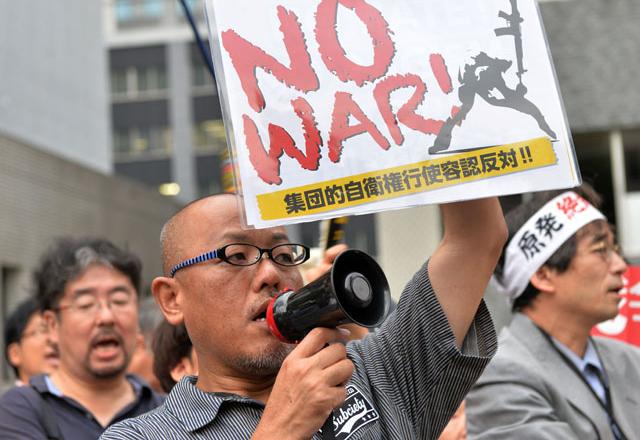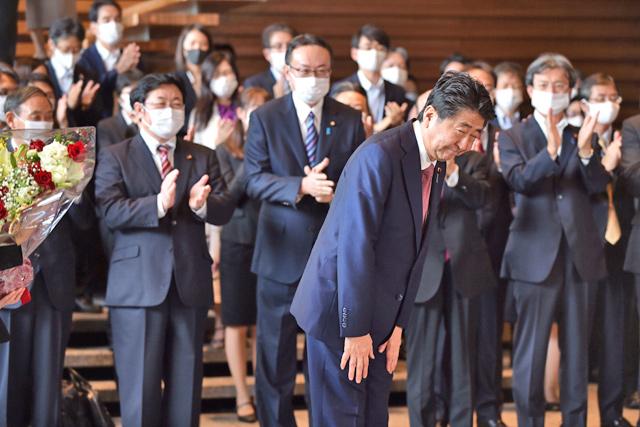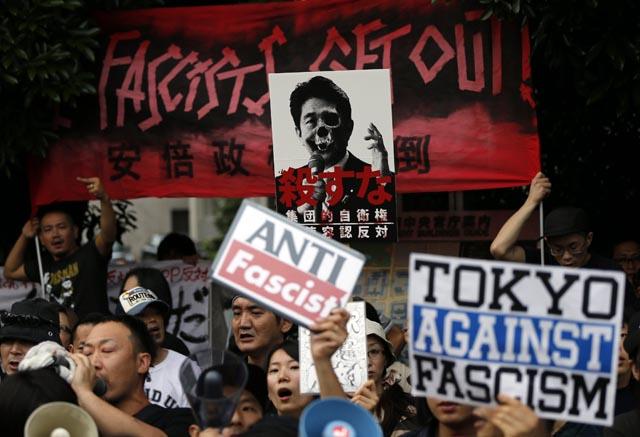You are here
Japan pushing on with military reform despite fiery suicide bid
By AFP - Jun 30,2014 - Last updated at Jun 30,2014

TOKYO — Pacifist Japan is pressing ahead with divisive plans to loosen restrictions on its military, a top government spokesman said Monday, despite widespread public anger and a protester’s horrific suicide bid.
Hundreds of people in the busy Tokyo district of Shinjuku watched on Sunday afternoon as a middle-aged man in a suit set himself ablaze above a footbridge, after making a speech opposing moves to let Japan’s well-equipped military fight on behalf of allies.
The dramatic suicide attempt was widely discussed on social media, with numerous videos and photographs posted by onlookers.
Many Internet users made the connection between the self-immolation and a groundswell of opposition to Prime Minister Shinzo Abe’s push to relax constitutional rules preventing Japan’s armed forces from going into battle.
Several thousand protesters showed up outside the premier’s Tokyo office on Monday evening, shouting slogans such as “no war” and “arrest the fascists” — as some carried posters showing Abe with a moustache similar to that of Adolph Hitler.
The conservative leader says regional tensions — including China’s increasingly assertive stance in various territorial disputes and an erratic North Korea — mean Japan must be better prepared to defend itself.
The United States, Tokyo’s chief ally, has backed Abe’s plans, but they are highly controversial at home, where voters feel deeply connected to the pacifism Japan adopted after World War II.
The government’s chief spokesman Yoshihide Suga on Monday refused to comment on the suicide attempt, but confirmed that the Cabinet would push ahead Tuesday with plans to change the interpretation of part of the pacifist constitution.
Japan’s military is currently barred from taking action, except in very narrow circumstances in which the country is attacked.
“We are in the final stage of the coordination between the ruling parties,” Suga told reporters. “Once a consensus is made between the ruling parties, we will have it approved by the Cabinet tomorrow.”
At least half the population is against a more aggressive military stance, according to the latest polls.
The liberal Mainichi newspaper said at the weekend that 58 per cent of voters are opposed, while the Nikkei business daily, in its poll published Monday, said 50 per cent of respondents were against the change.
China also warns against moves to bolster Japan’s military might, saying Tokyo is not sufficiently penitent over its actions in World War II.
It sent two ships into waters around disputed islands on Monday, a regular tactic in the long-running animosity.
Suga defended the plan, saying: “The government should protect people’s lives and property as well as the country’s safety... and if there is a defect in the current legal framework, we will address it.”
Tokyo police said Monday that nothing was known of the protester’s condition more than 24 hours after he was rushed to hospital with severe burns.
The dramatic suicide bid received scant coverage in mainstream media — which is sometimes criticised as servile. None of the national newspapers used a picture in their short reports.
Broadcaster NHK, whose chairman caused outrage earlier this year by suggesting that the state-funded body should not contradict the prime minister, did not cover the self-immolation on the day.
At least two private broadcasters did, however, using YouTube footage.
Popular protest in Japan has tended to be muted in recent decades, and protest suicides are very rare, with only a handful taking place in living memory.
In 1970, right-wing novelist Yukio Mishima disemboweled himself after a failed attempted coup, in protest against what he saw as an overly meek state.
In 1967, a 73-year-old man set himself alight in front of the prime minister’s official residence over the then-premier’s support for US bombing of North Vietnam.
Related Articles
TOKYO — Shinzo Abe smashed records as Japan’s longest-serving prime minister, championing ambitious economic reform and forging key diplomat
Japan on Tuesday loosened the bonds on its powerful military, proclaiming the right to go into battle in defence of allies, in a highly controversial shift in the nation’s pacifist stance.
TOKYO — Japan’s ruling party said Wednesday it will vote September 14 on a replacement for outgoing prime minister Shinzo Abe, who is steppi



















